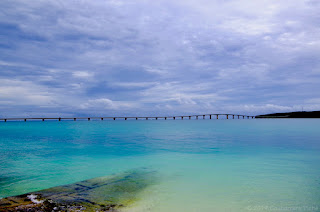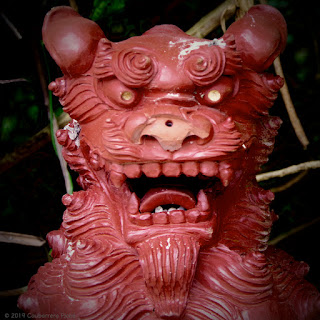Okonomiyaki
A kind of Japanese comfort food with distinct regional varieties, okonomiyaki is popular at neighborhood Shinto festivals and major events where street vendors are allowed to set up their tiny tents and propane fueled grills. More like a kind of pancake, okonomiyaki is with a wheat-flour based batter mixed with vegetables, pork, seafood, and a thick, sweet Worcestershire-kind of sauce. This photo shows a popular version of okonomiyaki with sunny-side-up eggs served on top with bonito flakes and sprinkled seaweed.
ISO 1600 at ƒ/5.6 for 1/100 sec.
#okonomiyaki #JapaneseFood #JapanesePancake #OsakaSoulFood #JapaneseCuisine #TorinoIchiFestival #Bandobashi #Yokohama
#お好み焼き #和食 #大阪のソウルフード #お祭り #祭り #酉の市 #金刀比羅大鷲神社 #阪東橋 #横浜
Kumade Hanging from Ceiling of Vendor Stand
A traditional bamboo ornamental rake where the claw part is heavily decorated with colorful traditional items that represent fortune and good luck. Kumade (lit. bear hand) rakes are sold at Tori-no-Ichi (lit. bird market) festivals in November on days of the rooster according to the lunar calendar. The kumade represents the clawing/raking of wealth and prosperity for one's business. A kumade the size of your hand can be bought for a thousand yen (roughly $10) while larger ones standing over 2 meters high (6 feet) can cost as much as 50,000 yen (roughly $500). Some very special kumade can be bought for over 10 million yen (roughly $100,000)!
ISO 800 at ƒ/4.5 for 1/60 sec.
#kumade #BambooRake #TorinoIchiFestival #FestivalofRooster #KotohiraOtoriShrine #Bandobashi #Yokohama
#熊手 #酉の市 #金刀比羅大鷲神社 #阪東橋 #横浜 #お祭り #祭り
Hotei: God of Contentment and Happiness.
A version of a kumada rake that has a pair of Buddha called Hotei in Japanese. Hotei are easily recognized by their broad smiles, bulging bellies, and a cloth bag they carry over their shoulder that never empties even as the Hotei hands out gifts to the poor, needy, and children. Hotei is also the patron saint of restaurateurs and bartenders, which makes this type of kumade popular among owners of eating and drinking establishments.
ISO 800 at ƒ/4.5 for 1/30 sec.
#Hotei #kumade #BambooRake #TorinoIchiFestival #FestivalofRooster #KotohiraOtoriShrine #Bandobashi #Yokohama
#布袋 #熊手 #酉の市 #金刀比羅大鷲神社 #阪東橋 #横浜 #お祭り #祭り
Candied Strawberries
Food stalls set up at and around the local Shinto Shrine during the Tori-no-Ichi Festival include many kinds of festival food and snacks. In addition to candied apples, candied grapes, and chocolate covered bananas, candied strawberries were very popular at this festival.
ISO 800 at ƒ/5.6 for 1/100 sec.
#strawberry #CandiedStrawberry #JapaneseFestivalFood #JapaneseStreetFood #TorinoIchiFestival #Bandobashi #Yokohama
#イチゴ #いちご飴 #お祭り屋台のいちご飴 #お祭り #祭り #酉の市 #金刀比羅大鷲神社 #阪東橋 #横浜
Goldfish
Among many kinds of games for children to play at a Japanese festival, a game dating back to 1810 called goldfish scooping (金魚すくい/kingyo-sukui) is a popular one where you use a paper scoop to carefully and quickly scoop up as many fish as you can before the paper scoop breaks. A special plastic bag is provided so that you can take the fish home to keep in a fishbowl.
ISO 800 at ƒ/5.6 for 1/100 sec.
#goldfish #GoldfishScooping #FestivalGames #TorinoIchiFestival #KotohiraOtoriShrine #Bandobashi #Yokohama
#金魚 #金魚すくい #金魚掬い #祭りのゲーム #お祭り #酉の市 #金刀比羅大鷲神社 #阪東橋 #横浜
Salt-Grilled Ayu
The sweet and juicy ayu, or sweetfish, is another common staple of street food vendors at festivals. Sweetfish, a smaller cousin of salmon, are heavily salted and grilled in a circle around a charcoal flame. Since you don't need a grill, propane gas, or any fancy sauce, salt-grilled sweetfish is the king of outdoor cooking when camping or having a barbecue on the shores of Japan's many crystal-clear mountain rivers.
ISO 800 at ƒ/5.6 for 1/100 sec.
#shioyakiayu #saltgrilledayu #skeweredfish #Japanesestreetfood #TorinoIchiFestival #Bandobashi #Yokohama
#あゆ #鮎 #塩焼き #お祭り #祭り #酉の市 #金刀比羅大鷲神社 #阪東橋 #横浜
Fortune Telling by Birthday
An omikuji is a single piece of paper folded into a tiny booklet sold at Shinto shrines and some Buddhist temples. This photo is of a huge billboard with omikuji that are sorted for each day of the year. After you purchase the tiny booklet (omkikuji) according to your date of birth, you unfold it to read a divination of your near future. Omikuji tell your fortune related to love, travel, business, illness, etc. Since every shrine has its own Kami (deity), the omikuji fortune telling can vary from shrine to shrine depending on what kind of kami is housed at that particular shrine. The Kami housed at the Kotohira-Otori Shrine here in Yokohama is a guardian deity for business prosperity. So, the omikuji sold here tend focus on telling fortunes related to businesses or financial matters.
ISO 800 at ƒ/4.5 for 1/30 sec.
#omikuji #fortunetelling #fortunepaper #Japanesefortune #TorinoIchiFestival #KotohiraOtoriShrine #Bandobashi #Yokohama
#誕生日別のおみくじ #御神籤 #お祭り #祭り #酉の市 #金刀比羅大鷲神社 #阪東橋 #横浜
Japanese Candied Fruit
Mizu-ame, which is a kind of honey-like syrup made from rice, potatoes, or barley, is s popular sweet sold at festivals where pieces of fruit are skewered with disposable chopsticks and cooled on a slab of ice before serving. Different fruit are used including mandarin orange slices, Japanese apricots, plums, cherries, strawberries, and more. Adding food coloring enhances the festive mood of this snack.
ISO 800 at ƒ/5.6 for 1/100 sec.
#mizuame #anzuame #JapaneseFestivalFood #JapaneseStreetFood #KotohiraOtoriShrine #TorinoIchiFestival #Bandobashi #Yokohama
#水飴 #あんず飴 #お祭り屋台 #お祭り #祭り #酉の市 #金刀比羅大鷲神社 #阪東橋 #横浜



























